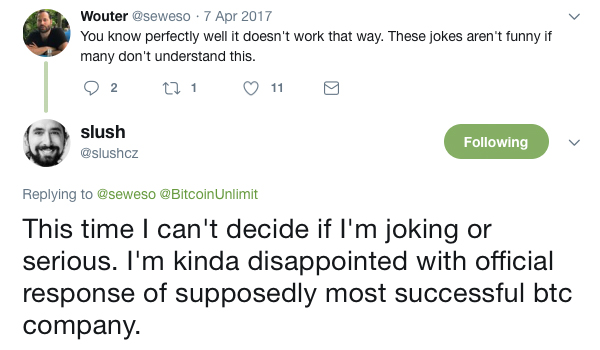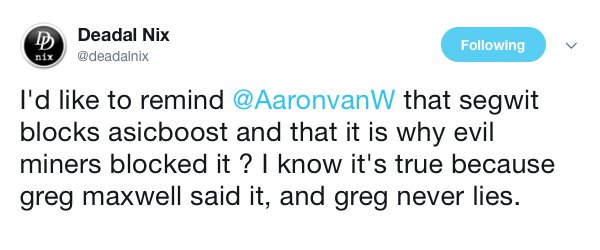
Back in the spring of 2017, the discussion of a technology called ‘ASIC Boost’ was a very hot debate amongst bitcoin proponents. Bitcoin core (BTC) supporters were extremely upset with the firm Bitmain Technologies and its owner Jihan Wu for allegedly using ASIC Boost covertly, even though the company denied it. Now according to reports the mining operation Slush Pool is compatible with ASIC Boost after the controversy was forgotten, and a company called ‘Little Dragon Technology’ made it available for any company as a Blockchain Defensive Patent License (BDPL).
Also read: What is Asicboost? — An Interview With Developer Jeremy Rubin
The Controversial ASIC Boost Was Once Called an ‘Attack’ to the Bitcoin Network and an ‘Exploit’
Last year there was a roaring debate about the use of a technology called ASIC Boost an improvement that provides mining chips with roughly 20-30 percent more efficiency. Developers Timo Hanke and Sergio Lerner invented ASIC Boost, but Bitmain was accused of using the technology covertly last spring, and bitcoin core supporters called it an “attack or exploit.”

Greg Maxwell was the first to kick off the heated argument and said miners covertly using the technology could outcompete other mining pools, and easily profit by $100 million USD per year or more. After Maxwell’s ‘revelation’ most people looked to blame Bitmain Technologies and its founder Jihan Wu, even though Wu and his company denied the allegations. Bitmain does hold patents in China for the ASIC Boost technology, but it has never been proven that the company used it covertly.
Many vocal supporters of the core software got upset with Jihan Wu and Bitmain over social media and forums across the net. When the news spread like wildfire that April, the founder of Slush Pool, Marek Palatinus, talked about ASIC Boost being an “attack” and called it “free hashrate” in a very long and telling Twitter conversation.
“Now it is clear how they can get that ‘free’ hashrate to attack bitcoin with empty blocks after Bitcoin Unlimited forks — ASIC Boost,” Palatinus states back in April.

After Being Very Controversial, the Technology Is Now Acceptable Because of Patent Law
However, a firm called Little Dragon Technology LLC has released the patent publicly to any company that abides by the BDPL structure of defensive patents. Because of this Palatinus and his operation Slush Pool has decided to utilize ASIC Boost and even refers to the protocol as an “optimization.” Slush Pool also details the organization’s motivation:
After reviewing the new Blockchain Defensive Patent License (BPDL), we would see beneficial for the community to have a central place with stratum protocol specification. At the same time, we have have been working on a proposal for stratum protocol extensions.

Last spring many individuals thought the debate about ASIC Boost was “overblown” and used as a divisive tactic against Bitmain and Jihan Wu. Professor Emin Gün Sirer out of Cornell University called the technology and “optimization” and said calling it an “exploit” was a bit far-fetched. Ryan X Charles the creator social media platform the Yours Network told news.Bitcoin.com that he believed the controversy was overblown as well calling ASIC Boost an “attack.” The well-known bitcoin developer Gavin Andresen explained his opinion that month stating:
It’s not ok for ethereum to change their rules to undo a theft, but it is ok for bitcoin to change the rules to prevent an optimization?

According to reports, Slush Pool is now fully compatible with ASIC Boost. Although there are no mining devices that support the ASIC Boost protocol unless the accusations of covert use are valid. Slush Pool used to command a lot more hashpower back in 2012-2016, but the operation’s hashrate has dropped significantly to under 10 percent of the BTC network hashrate. The company may believe the action of utilizing ASIC Boost can help increase Slush Pool’s hashrate, among all the other competing mining pools looking to improve efficiency. In addition to the announcement made by Slush, the company ‘Halong Mining,’ a controversial firm due to the uncertainty the mining devices truly exist, announced it’s ‘mining rigs’ would embed ASIC Boost into its Dragonmint mining machines.
What do you think about Slush Pool announcing it is compatible with ASIC Boost? Let us know in the comments below.
Images via Shutterstock, Pixabay, Slush Pool, and Twitter.
The bitcoin rabbit hole is deep. Explore the first tunnels over at bitcoin.com’s Price Index and Statistics data pages. It’s all the data you need to sound like you know what you’re talking about – learn all about hashrate, block sizes, transaction fees paid, mining difficulty and transactions per day. Instant expertise, right here.
The post From ‘Attack’ to ‘Optimization’ — Slush Pool Reveals ASIC Boost Compatibility appeared first on Bitcoin News.
Powered by WPeMatico
